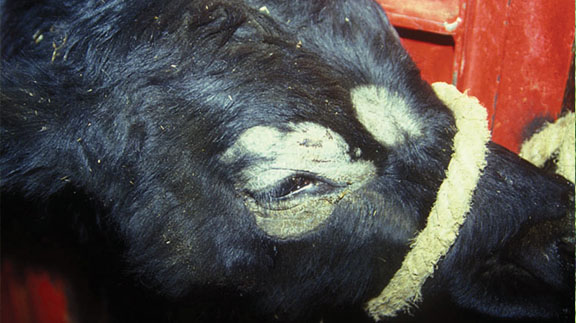Farm & Ranch
Livestock skin diseases

By Jessica Crabtree and
Dr. Jered Harlan, DVM
One of the most common skin diseases in cattle is ringworm. A fungal disease, ringworm often appears on calves and yearlings during winter, but normally vanishes by spring. The fungal skin disease is most often transferred by Trichphyton verrucosum, spore-forming fungi. The highly transmittable, infectious disease can spread from species to species, including humans. The spores, in a dry environment, can live for years. Having so many species of Trichophytin and Microsporum fungi, it is hard to build immunities against them. Direct contact with an infected
animal is the most common form of spreading the infection. Other ways the disease is spread is when an infected animal has rubbed on something in their natural environment such as a rope, halter and other equipment. The fungus establishes itself to the skin of the susceptible animal and is infiltrated through the hair follicle. The best way to halt the spread of the fungus is by disinfecting any equipment used on or around the animals.
Although unattractive, ring worm does not cause economic loss and does little to cause any permanent damage. Most common symptoms associated with the disease include grey-white areas of skin with an ash like surface, usually circular in outline and slightly raised. The size of lesions varies and can become extensive. To read more pick up the September 2015 issue of North Texas Farm & Ranch.
Farm & Ranch
Ag Elsewhere: Wyoming

By Tressa Lawrence
Babies are tucked away in every nook and cranny. Many ranchers across Wyoming have baby animals popping up all over this time of year.
Farm & Ranch
Ag Elsewhere: Montana

By Lindsey Monk
Another load of grain in to keep feeding the calves until the green grass can really start popping.
Farm & Ranch
Meanwhile, Back at the Ranch….

By Rayford Pullen | [email protected]
Spring has sprung and hopefully the rains will continue where our country will heal from the previous droughts and our grasses will thrive. We are especially hopeful for the Panhandle of Texas where our neighbors and friends have been dealt a deadly blow to homes, ranges, livestock, and people. Keep them in your prayers as they will not be able to return to normal for many years if at all. Having lost their ability to benefit from this great cattle market is a double whammy for all of them.
Now is the time of year when we need to take care of business as it relates to our new calves that have been hitting the ground this spring. First and foremost is vaccinating for Blackleg followed by deworming with a white wormer and the IBR complex. Blackleg is a soil-born disease and with pastures extremely short this spring our calves have been grazing the green grass as soon as it shows itself, making them even more vulnerable to picking contaminates from the soil.
To read more, pick up a copy of the April issue of NTFR magazine. To subscribe by mail, call 940-872-5922.
-

 Country Lifestyles1 year ago
Country Lifestyles1 year agoScott & Stacey Schumacher: A Growth Mindset
-

 Equine7 months ago
Equine7 months agoThe Will to Win
-

 Country Lifestyles7 years ago
Country Lifestyles7 years agoStyle Your Profile – What your style cowboy hat says about you and new trends in 2017
-

 Country Lifestyles4 years ago
Country Lifestyles4 years agoAmber Crawford, Breakaway Roper
-

 HOME7 years ago
HOME7 years agoGrazing North Texas – Wilman Lovegrass
-

 Country Lifestyles7 years ago
Country Lifestyles7 years agoDecember 2016 Profile, Rusty Riddle – The Riddle Way
-

 Country Lifestyles8 years ago
Country Lifestyles8 years agoJune 2016 Profile – The man behind the mic: Bob Tallman
-

 Country Lifestyles8 years ago
Country Lifestyles8 years agoCowboy Culture with Clay Reid – Being a Man






